Guitar Tone Woods
There are many fine woods used today to build quality
instruments. It is important to remember that one wood is not necessarily
"better" than another; the suitability of woods for any given
instrument depends on a number of factors, such as personal tastes and the type
of music you will be playing. For example, a bluegrass player will need woods
with a "quicker" response and louder tone than will a player of
country music, who would probably opt for a warmer, more mellow tone.
There are certain characteristics of certain woods
that can be seen to be detrimental to sound. For example, Mahogany yields a
quick response with great cutting ability, but to a small extent this cutting
power and midrange comes at the expense of bass response, producing a slightly
"thinner" tone than a Rosewood instrument. Similarly, Indian Rosewood
yields greater bass response and warmth of tone, but somewhat at the expense of
cutting power and balance, and can produce a "muddy" tone if not
properly voiced. Because of this, I voice the bracing of my instruments to match
the tonal characteristics of the woods used; Mahogany guitars are voiced to
yield greater bass response and warmer tone for overall balance, and Indian
Rosewood guitars are voiced to yield greater midrange and treble response as a
balance to the enhanced bass created by Indian Rosewood. CB instruments are not
just voiced to enhance the characteristics of the woods used, but to yield the
maximum tonal response available from each piece of carefully-selected wood,
which can vary significantly from piece to piece. This allows me to create an
instrument of greatest possible tone, clarity and volume. If you've ever
wondered why production instruments from even the most respected manufacturers
can vary so widely in terms of balance and clarity of tone, this is why: only a
maker who creates instruments one at a time and pays the most careful attention
to the tonal response of each piece of wood can achieve an instrument of the
ultimate power, balance and clarity of tone.
To help you decide which woods are right for you, I offer the
following descriptions of the types of wood that I typically use. There are many
other woods available to luthiers, such as Western Red Cedar, Walnut, and
Koa to name a few, and I will build you an instrument from any woods you prefer.
However, these are the woods that I have found to be able to offer the most
pleasing characteristics to the most people.
Note: all woods shown are unfinished. Photographs were
taken at the same distance from the camera and under the same lighting
conditions.
Sitka Spruce
(Picea sitchensis)
Sitka Spruce is the most popular wood for guitar tops
today. A native of the Pacific coast from Alaska to northern California,
Sitka Spruce is a strong, straight-grained, even textured
softwood. Sitka Spruce is sometimes called Silver Spruce. Because
of its large size (trees grow to nearly 300 feet in height),
straight grain, and elasticity, Sitka Spruce is valued for many
applications requiring strong, light weight lumber. Color is
creamy white to light pink or brown heartwood. Weight is about 27
pounds per cubic foot. Sitka Spruce has the highest strength to weight ratio of any wood
available today, and is a very tough wood that resists minor dings and
scratches very well. Sitka has a longer break-in time than Engelmann Spruce, and a somewhat more mellow tone with a slower response.
  
Sitka Spruce is Chris' "standard"
top wood, and is included in Chris' "base" guitar price. |
|
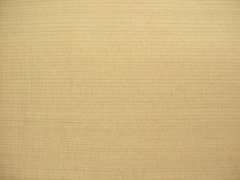
|
Engelmann Spruce
(Picea engelmannii)
Engelmann spruce is native to the
Rocky Mountain region from southwestern Alberta and
central British Columbia, south in the high mountains from
Washington to northern California, east to eastern Nevada,
southeastern Arizona and southern New Mexico and north to
Wyoming and central Montana. About two thirds of the
lumber is produced in the southern Rocky Mountain States.
Most of the remainder comes from the northern Rocky
Mountain States and Oregon.
Somewhat lighter in color than Sitka Spruce, Engelmann offers a quicker response and greater volume potential than Sitka.
Lighter in weight than Sitka Spruce (weighing
approximately 23
pounds per cubic foot) and a bit softer than Sitka Spruce, Engelmann is slightly more prone to
minor dings and scratches than Sitka. Still, Engelmann is by no means
"fragile" and will last a lifetime given proper care.
Although Engelmann Spruce does not have the
stellar reputation of Adirondack "Red" Spruce (see
below), it does exhibit the same tonal characteristics as Red
Spruce, and many players and collectors have learned that
Engelmann is a perfect substitute for the far rarer (and far
more expensive) Red Spruce.
Red Spruce can add substantially to
the cost of an instrument, but as Chris says, "There's
not a dime's worth of difference" tonally between
Engelmann Spruce and Red Spruce.
  
Engelmann Spruce is a no additional cost
upgrade on CB guitars.
|
|

|
Red (Adirondack) Spruce
(Picea rubens)
Red Spruce (also
known as Adirondack Spruce, Blue Spruce or Canadian
Spruce) is native to the Cape Breton Islands, Nova
Scotia and New Brunswick, west to Maine, southern Quebec
and southeastern Ontario and south to central New York,
northeastern Pennsylvania, northern New Jersey and
Massachusetts. It also grows in the Appalachian
Mountains of extreme western Maryland, eastern West
Virginia, northern and western Virginia, western North
Carolina and eastern Tennessee.
Red
Spruce was used for the tops on many of the great pre-war (now
vintage or collectible) American guitars. Red Spruce exhibits a
slightly lighter color than Sitka, but is generally not as white
as Engelmann. Like Engelmann, Adirondack is a softer than Sitka
and requires a bit more care, but this slightly softer wood
results in a top that is a bit less "stiff" and offers a
quicker response, with more "snap" to the note. Red
Spruce, like Engelmann, is also slightly lighter in
weight than Sitka Spruce, weighing approximately 26
pounds per cubic foot. Because
of the genetic qualities of this wood, as well as the
extreme rarity of guitar-width sets, Red Spruce will exhibit
more grain width and color variation than either Sitka or
Engelmann, and will often have a "striped"
appearance along its exceptionally straight grain.
Many players and collectors
believe that the use of this wood was a significant contributing
factor to the strong, clear tone of those older instruments.
Adirondack has been in short supply for decades (which is why the
major makers seldom use it anymore), and is therefore far more
expensive than other species of Spruce, but is considered
essential to many collectors and players seeking the ultimate
"vintage" sound.
  
Depending on
availability, Adirondack "Red" Spruce adds $100 to
the base cost of a CB guitar. |
|
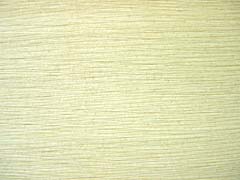
|
Mahogany
(Swietenia macrophylla)
Often called
Honduras Mahogany, Brazilian Mahogany, etc.,
depending on the country of origin, Mahogany is
native to Southern Mexico southward to Colombia,
Venezuela, and parts of the upper Amazon and its
tributaries in Peru, Bolivia, and Brazil.
Plantations have been established within
its natural range and elsewhere. Mahogany varies
in color from light to dark reddish-brown, to
deep rich red. Dark colored gum or white
deposits commonly occur in the pores; sometimes
rippled grain figure is present. Weight is 34 to
40 pounds per cubic foot.
Mahogany has often gotten a "bad rap" because
of its use on certain makers' more inexpensive instruments. Many players, such
as Doc Watson and Norman Blake (and Chris Bozung) prefer
Mahogany over Indian Rosewood because of its great clarity of tone and
cutting ability for lead guitar playing. I consider Mahogany to be one of
the finest, and most under-rated, tone woods
available.
  
Mahogany is Chris'
"standard" back & sides wood, and is
included in "base" guitar price.
Quilted Honduras Mahogany back &
sides:
$150 additional depending upon availability |
|
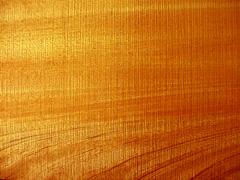
|
Curly Maple
(Acer macrophyllum or Acer saccharum)
Curly Maple has long
been a favorite of Country musicians for its beauty and
mellow tone. Curly Maple grows throughout most of North America, with
commercial species in the eastern United
States and Canada and the western coast
of the United States. Curly Maple yields
slightly less bass response and volume
than either Mahogany or Rosewood, but with greater "punch" and
"bite" to the note. Careful construction
maximizes this wood's bass and volume, and enhances Curly Maple's warm, mellow tone.
A strong, heavy wood (44+ pounds per
cubic foot) with cream to reddish-brown
heartwood, Curly Maple is often found
with Bird's-Eye, Burl, Fiddleback,
Quilted and other figured grain
patterns. Curly
Maple also takes a finish beautifully, and can be quite stunning visually.
  
Curly Maple back
& sides adds
$350 to the base cost of a CB guitar.
Curly Maple guitar neck is $100
additional. Curly
Maple banjo neck and resonator is a
standard option (no additional charge)
on CB banjos. |
|
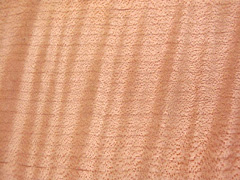
|
Brazilian Rosewood
(Dalbergia
nigra)
Of scattered
occurrence in the eastern
forests of the State of Bahia
and southward to Espirito Santo
and Rio de Janeiro and inland to
include Minas Gerais, Brazilian
Rosewood, due to its rarity, is an expensive tone
wood.
Because of long-time
exploitation, the tree has
become very scarce in the more
accessible regions. Brazilian
Rosewood is harder than the
commonly-used Indian Rosewood,
but is about the same density
and weighs the same (53 pounds
per cubic foot).
Often considered to be the "ultimate" in tone
wood, Brazilian Rosewood was used for the finest pre-war instruments by
the major manufacturers. Its balance, clarity of tone, quick response, and
beauty of color and figure are legendary. Hype aside, Brazilian Rosewood
really is an amazing tone wood for all these reasons; unfortunately, an
embargo was placed on this fine wood in the late 1960s, and since then
Brazilian Rosewood has not been imported into the United States. Because
of this, the quality of available Brazilian Rosewood has deteriorated to
the point that slab-sawn, knotty wood, which would have been scrapped for
kindling in the '40s, is today being touted as "high grade"
wood. Even the currently-available inferior grades of Brazilian Rosewood
are much more expensive than other tone woods,
and can add thousands of dollars to the cost of an instrument.
  
Please contact
us for pricing and availability. |
|
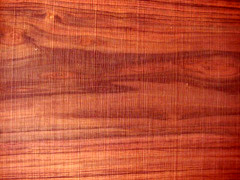
|
Indian Rosewood
(Dalbergia latifolia)
Indian
Rosewood grows throughout
the Indian peninsula
scattered in the dry
deciduous forests, but
is nowhere common; it
attains its best growth
in the Bombay region.
Indian Rosewood varies
in color from golden
brown to dark
purple-brown with darker
streaks giving an
attractive figure and a
narrowly interlocked
grain. Weighing
approximately 53 pounds
per cubic foot, Indian
Rosewood is heavier and
more dense than Mahogany.
Indian Rosewood yields a warm, "bassy"
tone as described above, and is thus often the preferred wood for rhythm
guitarists, especially for Bluegrass music.
Since the Brazilian Rosewood embargo of the late 1960s,
Indian Rosewood has become the tone wood of choice for most manufacturers'
high-end instruments.
  
Indian Rosewood adds
$150 to the base cost of a CB guitar. |
|
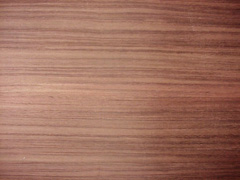
|
Honduran Rosewood
(Dalbergia
stevensonii)
Honduran
Rosewood
grows
only in
Belize
(British
Honduras),
occurring
in
fairly
large
patches
along
rivers
but also
on
inter-river
and
drier
areas
mostly
between
the
Sarstoon
and
Monkey
Rivers.
Honduran
Rosewood
is
typically
pinkish
brown to
purple
with
alternating
dark and
light
zones
forming
a very
attractive
figure,
with a
medium
to
rather
fine
grain. Denser than Indian rosewood, Honduran rosewood is well known
for its tonal properties, being the preferred wood for Marimba bars. It is one
of the
heavier
hardwoods,
weighing
60 to 70
pounds
per
cubic
foot. Tonally it
compares well to Brazilian rosewood, producing a well-balanced guitar
with great projection.
Honduran Rosewood is very similar visually and tonally to
the much
harder
to get Southeast Asian Rosewood; the grain lines are unusually tight and straight,
yielding a subtler beauty with less figure than Brazilian or Cocobolo.
  
Depending on
availability, Honduran Rosewood adds
$350 to the base cost of a CB guitar. |
|
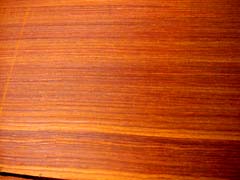
|
Cocobolo
(Dalbergia retusa)
Cocobolo is a true Rosewood that grows along the
Pacific seaboard from Central America to southern Mexico. A wood
of limited
occurrence,
Cocobolo
usually
grows
in
the
drier
upland
regions.
Weighing
approximately
68
pounds
per
cubic
foot, Cocobolo is harder, heavier and more
dense than other Rosewoods; because of this, Cocobolo is a better sound reflector,
absorbing less sound than the softer Rosewoods. Cocobolo's colors vary
greatly
from
light
to
deep
red
and
the
hues
of
the
rainbow,
yielding
stunningly
beautiful
colors
and
figure.
Cocobolo is
probably closer in tone, color and figure to the finest-grade Brazilian
Rosewood used on the classic guitars of yesteryear than any tone wood
available today, and for far less money than the inferior-quality
Brazilian currently available. Cocobolo offers
everything Brazilian Rosewood offers, and more: increased power,
increased sustain, increased volume, along with beauty of color and figure not
available in Brazilian Rosewood for years.
For the player seeking to
capture the sound and beauty of the finest Brazilian Rosewood from the
'40s and '50s, with the added benefits of greater power and sweeter
tone, Cocobolo is hard to beat. I consider Cocobolo to be superior in
every
way
to
the
currently-available
Brazilian
Rosewood,
and
with
about
one-third
to
one-tenth
of
the
cost
of
Brazilian,
Cocobolo
is
a
real
bargain.
I cannot recommend this excellent tone
wood
highly
enough.
  
Cocobolo adds
$350 to the base cost of a CB
guitar. |
|
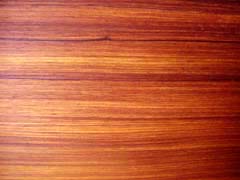
|
As you can see, the woods used can have a great effect on the
sound of an instrument, but the maker who has an understanding of these woods
and the ability to maximize the positive qualities of the woods used can have an
even greater impact upon an instrument's ultimate success. I hope I have
enlightened you about the qualities of different types of woods available today,
and I hope you will give CB Guitars the opportunity to create for you the
instrument of a lifetime.
Sincerely,


Last modified: March 20, 2019 |
![]()